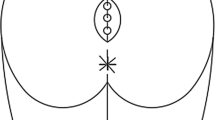Abstract
Purpose
Our aim was to determine the most effective surgical procedure for treatment of pilonidal disease, by comparing different surgical techniques.
Methods
A total of 354 patients who underwent operation for pilonidal disease were enrolled in this prospective study. The data included patient’s demographic characteristics, age, gender, body mass index, occupation, smoking, concomitant diseases, surgeon’s experience, wound-healing problems (wound separation and infection), time to return to work, and development of recurrence.
Results
Of the 354 patients, total excision + primary closure was performed in 133 (37.6%), D-flap in 101 (28.5%), Karydakis technique in 74 (20.9%), and Limberg flap surgery in 46 (13%). The male/female ratio was 8.5:1, which is a statistically significant difference (p < 0.05). The average follow-up period was 37 months (range, 12–97 months); during this period, wound-healing problems were observed in 70 (19.7%) patients, and 34 (9.6%) patients developed recurrence. There was no difference in the rate of recurrence of pilonidial disease between procedures done by trainees and staff surgeons. Recurrence rates were similar for all four treatment methods (7.5–13.5%). Wound-healing problems were higher for D-flap than for other methods (p = 0.027). The average time to return to work with the D-flap method was longer than that for the other methods (p < 0.01). Recurrence increased 14.44-fold following the development of wound infection. Higher recurrence rates were also noted in obese patients (8.10-fold) and in females (6.72-fold).
Conclusions
Despite the increasing volume of data on the treatment of pilonidal disease, the optimal treatment has yet to be established.




Similar content being viewed by others
References
Kitchen PR (1996) Pilonidal sinus: experience with the Karydakis flap. Br J Surg 83:1452–1455
Mann CV, Springall R (1987) D-excision for sacrococcygeal pilonidal sinus disease. J R Soc Med 80:292–295
Azab AS, Kamal MS, Saad RA, al Atta KA Abou, Ali NA (1984) Radical cure of pilonidal sinus by a transposition rhomboid flap. Br J Surg 71:154–155
Karydakis GE (1992) Easy and successful treatment of pilonidal sinus after explanation of its causative process. Aust N Z J Surg 62:385–389
Petersen S, Koch R, Stelzner S, Wendlandt TP, Ludwig K (2002) Primary closure techniques in chronic pilonidal sinus: a survey of the results of different surgical approaches. Dis Colon Rectum 45:1458–1467
Topgül K (2010) Surgical treatment of sacrococcygeal pilonidal sinus with rhomboid flap. J Eur Acad Dermatol Venereol 24(1):7–12
Petersen S, Aumann G, Kramer A, Doll D, Sailer M, Hellmich G (2007) Short-term results of Karydakis flap for pilonidal sinus disease. Tech Coloproctol 11:235–240
Toccaceli S, Persico Stella L, Diana M, Dandolo R, Negro P (2008) Treatment of pilonidal sinus with primary closure. A twenty-year experience. Chir Ital 60:433–438
Karakayali F, Karagulle E, Karabulut Z, Oksuz E, Moray G, Haberal M (2009) Unroofing and marsupialization vs. rhomboid excision and Limberg flap in pilonidal disease: a prospective, randomized, clinical trial. Dis Colon Rectum 52:496–502
Nordon IM, Senapati A, Cripps NP (2009) A prospective randomized controlled trial of simple Bascom’s technique versus Bascom’s cleft closure for the treatment of chronic pilonidal disease. Am J Surg 197:189–192
Nursal TZ, Ezer A, Calikan K, Törer N, Belli S, Moray G (2010) Prospective randomized controlled trial comparing V-Y advancement flap with primary suture methods in pilonidal disease. Am J Surg 199:170–177
Darwish AM, Hassanin A (2010) Reconstruction following excision of sacrococcygeal pilonidal sinus with a perforator-based fasciocutaneous limberg flap. J Plast Reconstr Aesthet Surg 63:1176–1180
Krand O, Yalt T, Berber I, Kara VM, Tellioglu G (2009) Management of pilonidal sinus disease with oblique excision and bilateral gluteus maximus fascia advancing flap: result of 278 patients. Dis Colon Rectum 52:1172–1177
Ekmel Tezel (2009) Pilonidal Hastaliğin Cerrahi Tedavisi, Nobel Tip Kitabevleri, Ankara, Bascom J 5-15
Can MF, Sevinc MM, Yilmaz M (2009) Comparison of Karydakis flap reconstruction versus primary midline closure in sacrococcygeal pilonidal disease: results of 200 military service members. Surg Today 39:580–586
Anderson JH, Yip CO, Nagabhushan JS, Connelly SJ (2008) Day-case Karydakis flap for pilonidal sinus. Dis Colon Rectum 51:134–138
Jamal A, Shamim M, Hashmi F, Qureshi MI (2009) Open excision with secondary healing versus rhomboid excision with Limberg transposition flap in the management of sacrococcygeal pilonidal disease. J Pak Med Assoc 59:157–160
Coşkun F, Bilgin A, Karabeyoğlu M, Yildirim O, Eroglu A (1996) Pilonidal sinus’un geliştirilmiş flep disseksiyonu yöntemi ile tedavisi. Türkiye Klinikleri J Med Sci 16:72–76
McCallum I, King PM, Bruce J (2007) Healing by primary versus secondary intention after surgical treatment for pilonidal sinus. Cochrane Database Syst Rev 17:CD006213, Review
Doll D, Krueger CM, Schrank S, Dettmann H, Petersen S, Duesel W (2007) Timeline of recurrence after primary and secondary pilonidal sinus surgery. Dis Colon Rectum 50:1928–1934
Doll D, Evers T, Matevossian E, Petersen S (2009) Outcome of chronic pilonidal disease treatment after ambulatory plain midline excision and primary suture. Am J Surg 197:693–694
Al-Khayat H, Al-Khayat H, Sadeq A et al (2007) Risk factors for wound complication in pilonidal sinus procedures. J Am Coll Surg 205:439–444
Sakr M, El-Hammadi H, Moussa M, Arafa S, Rasheed M (2003) The effect of obesity on the results of Karydakis technique for the management of chronic pilonidal sinus. Int J Colorectal Dis 18:36–39
Ersoy E, Devay AO, Aktimur R, Doganay B, Ozdoğan M, Gündoğdu RH (2009) Comparison of the short-term results after Limberg and Karydakis procedures for pilonidal disease: randomized prospective analysis of 100 patients. Colorectal Dis 11:705–710
Tezel E, Bostanci H, Anadol AZ, Kurukahvecioglu O (2009) Cleft lift procedure for sacrococcygeal pilonidal disease. Dis Colon Rectum 52:135–139
Conflicts of interest
None.
Author information
Authors and Affiliations
Corresponding author
Rights and permissions
About this article
Cite this article
Saylam, B., Balli, D.N., Düzgün, A.P. et al. Which surgical procedure offers the best treatment for pilonidal disease?. Langenbecks Arch Surg 396, 651–658 (2011). https://doi.org/10.1007/s00423-011-0768-9
Received:
Accepted:
Published:
Issue Date:
DOI: https://doi.org/10.1007/s00423-011-0768-9




